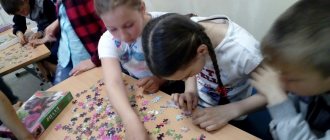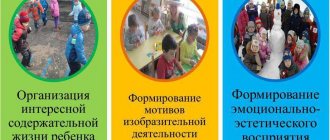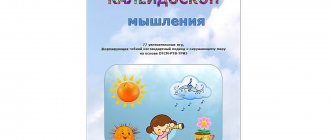Goal, objectives
The goal of this direction in education is the formation of an aesthetic culture in a person, which consists of the following aspects:
- Perception. This is the ability to notice various forms of manifestation of beauty, including in nature, work, and everyday life.
- Feelings. The ability to emotionally evaluate harmony and perfection.
- Needs. The desire to receive aesthetic pleasure, to contemplate works of art, the beauty of nature.
- Tastes. Ability to conduct assessments. Analysis of real world objects from an aesthetic position.
- Ideals. Individual ideas about what is perfect and harmonious in nature, people, and art.
The goal of aesthetic education is specified in a number of tasks:
- Developing in a child the ability to see beauty and appreciate it.
- Formation of a harmonious personality.
- Development of artistic taste.
- Formation of an aesthetic ideal, the desire to become beautiful not only externally, but also internally, in actions, thoughts, and deeds.
- Stimulating creative abilities and the desire for their development.
As a result of upbringing, a child must understand what harmony and perfection are, be able to empathize, be distinguished by emotional responsiveness, and imagination.
Tips and tricks for parents
It is important to carry out aesthetic education of the child by all available means, creating a harmonious environment for him, giving him the opportunity to independently engage in artistic creativity in the chosen direction. Parents need to talk with the baby and give answers to all the questions he has. And classes with a teacher will help develop taste.
When choosing forms of work, you should focus on the age of the baby:
- Visiting the theater is permissible from 1.5 years of age; the repertoire of puppet theaters includes short-lasting productions that will not have time to tire the baby.
- You can talk about paintings, musical works, and talk about their authors from the age of 3–4; children already understand a lot and will definitely listen with interest and ask questions.
- At 4–5 years old you can visit an exhibition, including a library one.
- At 5-6 years old - go to the Philharmonic or ballet.
Giving a child the opportunity to create is another method of aesthetic education, and he can choose the type of activity to his liking. Some people like to draw pictures in the sand, while others like to write short congratulatory poems for mom or dad. Parents should not limit creative impulses, but give their child the freedom to choose and realize their own ideas.
Do not underestimate the importance of aesthetic education for preschoolers; it will help to spiritually enrich the child’s personality, make him developed, rich, able to feel subtly and receive aesthetic pleasure.
Projects within the framework of artistic and aesthetic development of preschool children
"How beautiful this world is"
Content part:
- “Art is a wonderful world of beauty.” Goals: introducing students to examples of works of art, developing skills in understanding the world of painting, developing the ability to express their aesthetic impressions, and developing speech.
- "Magic Flower" Collaborative painting with watercolors and wax crayons. Goals: Using various materials and visual techniques, to activate children’s free experimentation, develop creative imagination, imaginative thinking, and a sense of color. Teach non-traditional artistic techniques for depicting flowers.
- "Beautiful moments of summer." Monotype. Objectives: To teach the skills of depicting mirror-symmetrical prints. To familiarize children with the rules of drawing up a harmonious color composition and to improve the visual technique of watercolor.
- "The concept of still life." Objectives: To introduce the features and history of the development of the still life genre. Learn to correctly describe the thoughts and emotions that a painting evokes.
- "Autumn Foliage Ball" Semolina paintings with appliqué elements. Goals: organize and conduct a game in an art museum. To teach the ability to create pictures from semolina using paints, to develop a sense of color.
- "Scenery". Objectives: To introduce the features and history of the development of the landscape genre. Learn to correctly describe the thoughts and emotions that a painting evokes.
- "Autumn landscape". Fine technique of grisaille. Goals: mastering drawing with charcoal or sanguine, conducting experimental work with one color, achieving different shades.
Video: drawing with palms and fingers
“The World of Classical Music” (duration 1 year)
Plan.
- September. Acquaintance with the creative musical heritage of P.I. Tchaikovsky "Children's Album".
- October. Introduction to classical ballet as a genre of plastic art. "Sleeping Beauty", "Nutcracker".
- November. Discussion of the works of P.I. Tchaikovsky, the formation in children of the perception of dance movement as a way of conveying a musical image.
- December - January. Introduction to European classical music: Bach, Mozart, Beethoven.
- February. Conducting an integrated lesson in fine arts and music, learning to convey musical impressions and experiences in drawing.
- March, April. Acquaintance with the ancient dance tradition (minuet, gavotte).
- May. Final conversation for children and parents “Conversations about music.”





